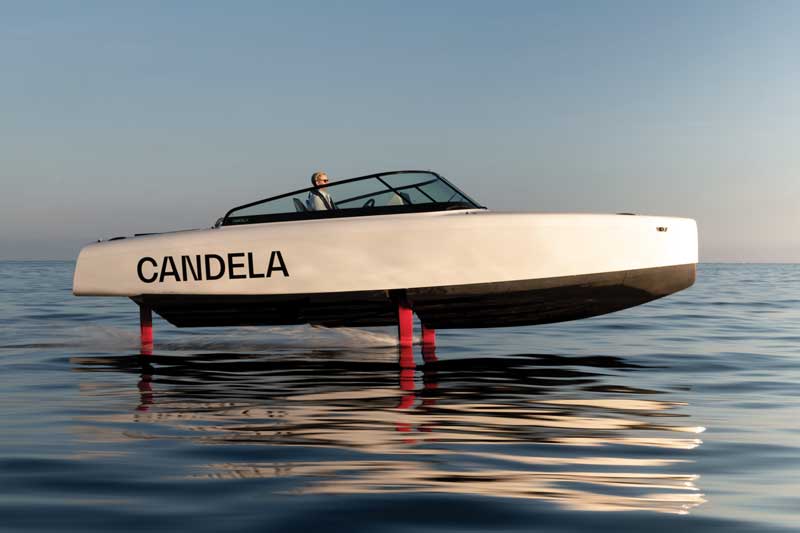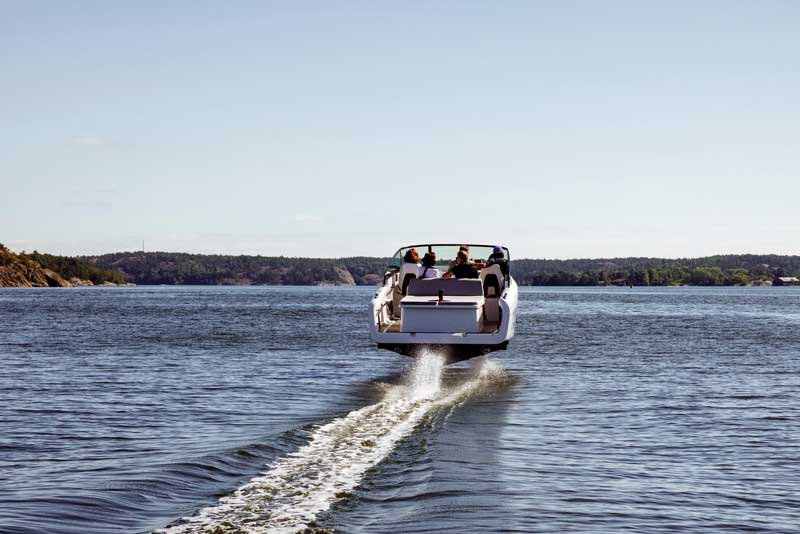The Candela C-8 is an electric hydrofoiling powerboat built in Sweden. You may have seen it on the Demo Dock at the Annapolis Powerboat Show in October. But to really appreciate all this tech, you simply must go for a test ride.
When developing the C-8, Candela wanted to create a more efficient drivetrain that would eliminate maintenance and noise. Enter the Candela C-Pod, the first electric pod motor designed for high-speed boats. Instead of having one big propeller and one big motor delivering the torque that the boat needs, Candela split the torque up into two motors and two contra-rotating propellers. There is no transmission but an electric direct drive, which means no noise from gears, no oil or cooling fluid changes (the sealed electric motors are cooled by seawater), and no maintenance. It provides 23 percent more range than the best electric boats and will last 3000 hours without service. And because the motors are placed under the water, the boat runs whisper quiet. The tech that Candela has created is fully scalable, so it can be built for bigger and bigger vessels.
Now let’s talk hydrofoiling. Hydrofoils remove 50 percent of the drag compared to a planing boat. In order to get more efficiency out of the system, Candela opted for fully submerged foils. Similar to an airplane, Candela’s boats use a large straight main foil close to the boat’s center of gravity and a smaller T-foil in the aft. Batteries are very heavy, so to make the boat as light as possible, yet still rigid and strong, the hull is made of 100 percent carbon fiber. This allows Candela vessels to weigh significantly less than a similar boat of the same size. The foils are also fully retractable for storage and shallow water operation.

By lifting the boat out of the water on hydrofoils, you reduce the energy needed to push it forward by about 80 percent. According to Candela, it works like this: when you run a wing through fluid, the fluid has to increase its speed, and if something increases its speed, it increases its energy. That energy then needs to be lowered somewhere else to preserve the energy. In the case of the C-8, the pressure drops. The wing is shaped so you get a pressure drop at the topside of the wing and a pressure increase at the lower side of the wing. Once that has been achieved, you get a push upwards, lifting the hull out of the water.
So, we have foils and an ultra-lightweight boat—what’s missing? Software and electronics to tie everything together. Candela’s flight control system uses a variety of sensors to estimate the position, velocity, and acceleration of the boat on all axes. It combines measurement from more than 10 sensors to estimate the true state of the system at all times. These sensors and the computer programming are constantly changing the level of attack of the wings to keep the boat stable when it is out of the water.

Candela claims that their boats are some of the most efficient ever made. At 20 knots, the consumption is only 1 kWh per nautical mile, which is roughly 0.1 liters of gasoline. The C-8 has a top speed of 27 knots, an estimated range of 57 nautical miles at 22 knots, and foiling mode can be achieved for all speeds above 16 knots. It can fit eight passengers and features a comfortable interior that could sleep a small family, a marine head, and ample storage. It is available in a Daycruiser, with options for open, T-Top, or hardtop, or a Center Console configuration that comes as an open layout or T-Top.
What does it feel like out on the water? Pretty darn incredible if we do say so ourselves! As the boat lifts out of the water, it truly feels like flying. It is remarkably smooth, very quiet, and very comfortable. While it was a relatively flat, low-wind day during our test ride, we were able to jump across boat wakes with ease. I would love to experience the C-8 on a rougher Bay day to see how it compares.
To learn more, visit candela.com/candela-c-8.
By Kaylie Jasinski
Candela C-8 Specifications:
LOA: DC – 28 ft. 3 in., CC – about 29.5 ft.
Beam: 8 ft. 3 in.
Draft: 1 ft. 8 in. in shallow mode, 2 ft. 11 in. in planing mode, 2 ft. 7 in. while foiling, 4 ft. 11 in. while not foiling, foils extended
Battery: 69 kWh
Charging: 11 kW AC: 6.5 hr. 0-100 percent, 135 kW DC: 35 min. 10-80 percent
Weight: 3858 lbs.